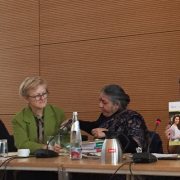Five countries’ ocean and coastal policies shortlisted for the 2012 Future Policy Award
Press release – for immediate release
How can we save the world’s oceans and coasts?
Five countries’ ocean and coastal policies shortlisted for the 2012 Future Policy Award
Hamburg/Montreal/Washington D.C./Rome, 4 September – Six policies from five countries are now shortlisted for the 2012 Future Policy Award, an international award that celebrates effective and
exemplary policies. California, Namibia, Palau, the Philippines, and South Africa are still in the running. This year the topic of the award is the protection of oceans and coasts. Thirtyone
different policies from 22 countries were nominated, ranging from integrated ocean and coastal policies, marine protected area programmes to laws regulating fisheries, trade in marine products, marine litter and land-sea interactions.
The Future Policy Award is granted by the World Future Council, an international policy research organisation that provides decision makers with effective policy solutions. The winning policy will be announced at the United Nations Headquarters in New York in September 2012. Winners will be celebrated at the 11th Conference of the Parties to the Convention on Biological Diversity in
Hyderabad, India, in October. For this year’s theme the World Future Council is partnering with the Secretariat of the Convention on Biological Diversity (CBD), the Global Environment Facility (GEF) and the Food and Agriculture Organization of the United Nations (FAO), with support from the Okeanos Foundation.
More information on the award process can be found online at the World Future Council’s website www.worldfuturecouncil.org and on the blog of the Future Policy Award team www.futurepolicyaward.org.
Overview of Shortlisted Policies
California’s Ocean Protection Act, 2004
Oceans and coasts play a central role in the economy and lifestyle in the state of California. However, dense urban population and multiple uses of the marine environment have resulted in conflict over tight resources, unregulated coastal development and a decline in quality of the marine environment. The California Ocean Protection Act has accelerated ecosystembased
ocean management through marine spatial planning and has enabled the creation of 124 connected marine protected areas. The Act created the mandate for the Ocean Protection Council, which sets guidelines and provides a central coordinating body between state agencies and defines a funding stream. Since 2004, there has been broad public participation in an area of policy that is typically closed to the general public and there has been a strong emphasis on making scientific data available to all. Its implementation has resulted in the State of California being a global forerunner in marine spatial planning and in implementing a coordinated marine protected area network.
Namibia’s Marine Resources Act, 2000
Namibia successfully manages its marine resources and has instituted a more ecologically and economically sustainable fishing industry by implementing a rightsbased
and scientific approach to fisheries management. The country inherited severely overexploited and unregulated fisheries when it gained independence in 1990. The Marine Resources Act established strict monitoring and control systems and regulations addressing the key drivers of degradation of marine capture fisheries: by-catch, illegal fishing, overcapacity from subsidies and harmful fishing gear. The fishing industry has created new jobs and improved food security for Namibians. Most fish stocks are now stable, and fishing license fees and levies on catches contribute to the national economy.
Palau’s Protected Areas Network Act, initiated in 2003
Palau’s Protected Areas Network Act establishes the framework for a network of marine and terrestrial protected areas ensuring a longterm sustainable use of natural resources. The Act involves local communities by enabling them to undertake a scientific and social assessment of their local environment and supports traditional systems of natural resource management, which have a long
history in Palau. To date, 35 protected areas have been designated, including reefs, lagoons, mangroves and a sardine sanctuary. Some sites permit sustainable harvest of fish and other natural
resources, whilst others have been declared notake zones. Palau seeks to protect 30 per cent of its nearshore marine environment and 20 per cent of its terrestrial environment by 2020.
Palau’s Shark Haven Act, 2009
An estimated 73 million sharks are hunted every year and in addition to the loss of these magnificent creatures, diminishing populations have serious ecological effects. Palau has taken a global lead in shark protection by declaring its entire territorial waters a sanctuary for all shark species. Fishing for sharks has been banned and any sharks caught in the nets of other fisheries have to be released unharmed, and there are substantial fines for violators. Palau has also recognised the economic benefits of protecting sharks rather than hunting them: the shark diving industry contributes US$1.2 million in salaries to local communities and generates US$1.5 million in taxes for the government annually. Other countries, including Honduras, the Maldives and the Bahamas have followed the example of Palau and banned shark fishing in their national waters.
The Philippines’ Tubbataha Reefs Natural Park Act, 2010
The Tubbataha Reefs are a UNESCO World Heritage Site located in the Coral Triangle, a hotspot of marine biodiversity. Despite regional threats including overfishing these reefs are in excellent condition. The Tubbataha Reefs Natural Park Act demonstrates the critical need for national level policy to support local level action, giving permanence and power to local level institutions to confront regional threats such as illegal fishing, poaching and destructive fishing practices undertaken by foreign vessels. Tubbataha has shown that with carefully planned management, local communities need not bear the burden of closed protected areas, but can be their primary beneficiaries: as a nursery ground for fish, the reefs are supporting local artisanal fisheries. This is an example of successful coral reef conservation and a model for action on other coral reefs.
South Africa’s Integrated Coastal Management Act, 2008
South Africa has been addressing the daunting challenge of promoting human wellbeing whilst maintaining ecological integrity along its diverse coastline. The Integrated Coastal Management Act is the result of a highly participatory and consultative process, which has been the signature of the transition from Apartheid to democracy. Central to the Act is reinstating historic common property rights to the coast that were denied during Apartheid. It defines coastal zone for the first time and sets guidelines for management plans at local, provincial and national levels. Complementary programmes have supported the goals of the act by employing vulnerable people to conserve the coastal environment.
Media Contacts
World Future Council
Anne Reis
Media & Communications
Mexikoring 29
22297 Hamburg
Phone: +49 40 30 70 914-16
Fax: +49 40 30 70 914-14
anne.reis@worldfuturecouncil.org
The Convention on Biological Diversity (CBD)
David Ainsworth
+1 514 287 7025
david.ainsworth@cbd.int
Johan Hedlund
+1 514 287 6670
johan.hedlund@cbd.int.
The Food and Agriculture Organization (FAO)
Tina Farmer
tina.farmer@fao.org
+39 06 570 56846 / + 39 340 161 4006
Irina Utkina
irina.utkina@fao.org
+39 06 570 52542 / +39 34 88 967 961
The Global Environment Facility
John Diamond
jdiamond@thegef.org
+1 202 458 7953
The World Future Council brings the interests of future generations to the centre of policy making. It consists of up to 50 eminent members from around the globe who have already successfully promoted change. The Council addresses challenges to our common future and provides decision makers with effective policy solutions. The World Future Council is registered as a charitable foundation in Hamburg, Germany. Opened for signature at the Earth Summit in Rio de Janeiro in 1992, and entering into force in December 1993, the Convention on Biological Diversity is an international treaty for the conservation of biodiversity, the sustainable use of the components of biodiversity and the equitable sharing of the benefits derived from the use of genetic resources. With 193 Parties, the Convention has near universal participation among countries. The Convention seeks to address all threats to biodiversity and ecosystem services, including threats from climate change, through scientific assessments, the development of tools, incentives and processes, the transfer of technologies and good practices and the full and active involvement of relevant stakeholders including indigenous and local communities, youth, NGOs, women and the business community. The Cartagena Protocol on Biosafety is a subsidiary agreement to the Convention. It seeks to protect biological diversity from the potential risks posed by living modified organisms resulting from modern biotechnology. To date, 161 countries plus the European Union have ratified the Cartagena Protocol. The goals of the Food and Agriculture Organization of the United Nations are to reduce hunger and malnutrition, eliminate poverty through economic and social progress and support sustainable The GEF unites 182 countries in partnership with international institutions, civil society organisations (CSOs), and the private sector to address global environmental issues while supporting national sustainable development initiatives. Today the GEF is the largest public funder of projects to improve the global environment. An independently operating financial organisation, the GEF provides grants for projects related to biodiversity, climate change, international waters, land degradation, the ozone layer, and persistent organic pollutants. Since 1991, the GEF has achieved a strong track record with developing countries and countries with economies in transition, providing $10 billion in grants and leveraging $47 billion in cofinancing for over 2,800 projects in over 168 countries. For more information, visit www.thegef.org. Okeanos funds scientific projects devoted to marine conservation and makes their findings available to the public. The Foundation also aims to render the fascinating wonders of the deep more widely known. For more information visit www.okeanosfoundation.org.The World Future Council
The Convention on Biological Diversity (CBD)
The Food and Agriculture Organization (FAO)
management and utilization of natural resources. The Food and Agriculture Organization of the United Nations leads international efforts to defeat hunger. Serving both developed and developing countries, FAO acts as a neutral forum where all nations meet as equals to negotiate agreements and debate policy. FAO is also a source of knowledge and information. FAO helps developing countries and countries in transition modernise and improve agriculture, forestry and fisheries practices and ensure good nutrition for all. Since the founding in 1945, FAO has focused special attention on developing rural areas, home to 70 percent of the world’s poor and hungry people.
The Global Environment Facility
Okeanos – Foundation for the Sea







